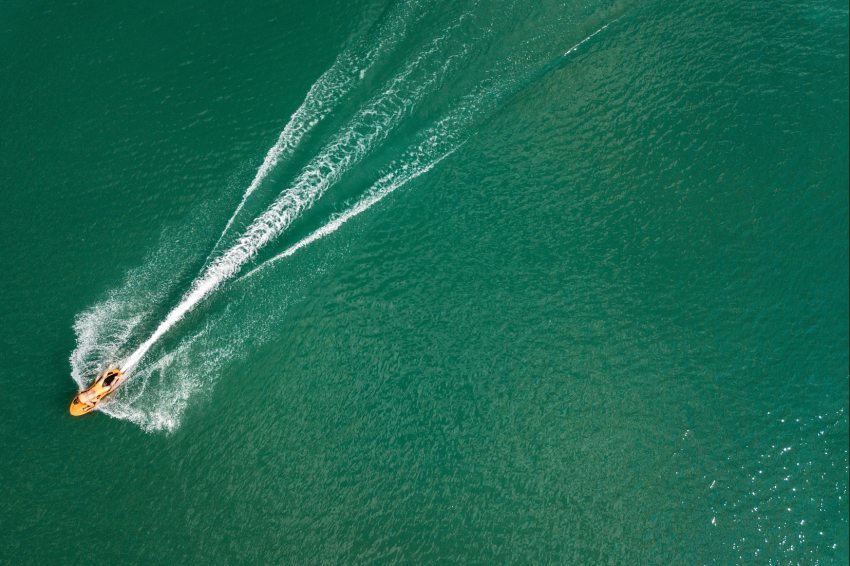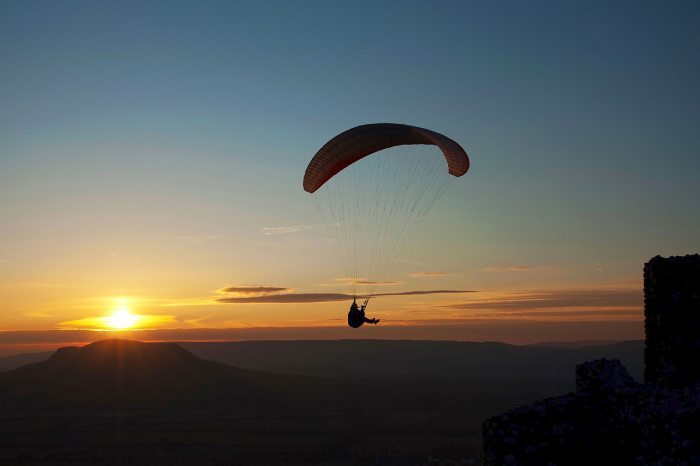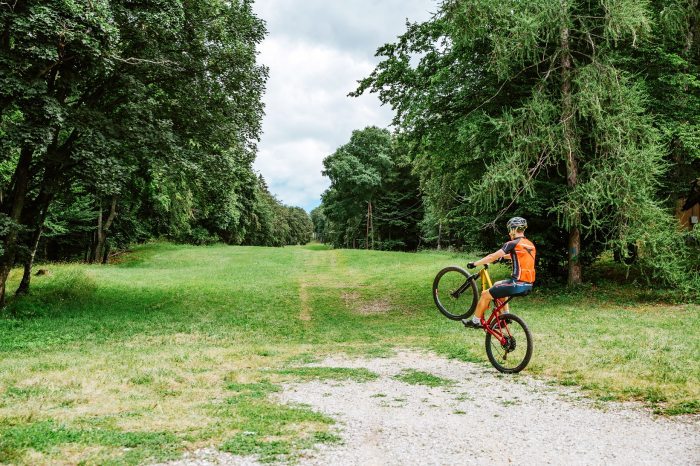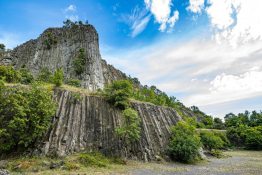Looking for extreme adventures? – Venues in Hungary for extreme sports fans
Wakeboarding, diving, paragliding, rock climbing, mountain biking... This list will make the extreme sports enthusiast's eyes light up. But the following list is not just for them, it's also for those who are just starting out but don't know where to begin. We've put together a selection of places in Hungary that are worthy candidates for the title of favourite destinations for extreme sports fans.

Get on the wakeboard!
Wakeboarding is an easy-to-learn extreme sport invented by surfers who wanted to indulge their passion even when there were no big waves. So they invented the idea of being pulled by a rope attached to a motorboat and later built cableways specifically for this purpose. Fans of this sport, which is particularly popular with young people, now have access to a number of wakeboard tracks built on natural water in Hungary.
Lupawake in Budakalász is one of the most professional wakeboarding venues in the country, with four different levels of ropes and twenty-two world-class elements. The Venice Beach Cable Park is located on Lake Velencei next to the open-air beach and the Velence Korzo, but it has become a favourite not only for its idyllic location but also for its 800-meter, five-pole track, which hosts the national wakeboard championships.
The Lido beach in Vonyarcvashegy is one of the best beaches on Lake Balaton in itself, and the exciting 820metres long, five-pole water skiing track is a magnificent bonus.
Another excellent choice is the Bamboo Island in Siofok, which really is an island: located eighty meters from the coast on a 460 square meter pier, it offers wakeboarding lovers a five-pole track no less than a kilometer long.
It's worth a try, as wakeboarding on the open waters of Lake Balaton is a really cool experience.
Where else in Hungary do you find wakeboarding facilities? Near Budapest, you can try this extreme water sport in Dunaharaszti, Martonvásár, or Gyömrő, around Lake Balaton in Balatonfüred, but beginners and advanced wakeboarders can also enjoy it in Kecskemét, Győr, Pécs, Szeged, and Nyíregyháza.
Via Ferrata - more than hiking
Via Ferrata is an Italian term meaning an iron track or climbing path. It refers to mountain trails on which various cables, chains, iron ladders, stairs, etc., are securely installed to allow safe passage. Although via ferrata trekking does not require rock climbing skills, it does require physical fitness, practice, and equipment. The difficulty levels of the routes are indicated on a scale from A to E, where the rating is always determined by the most difficult point of the marked section. However, before anyone sets off on a trail, it is important to know that you must be accompanied by a guide for the first time, and it is essential to learn how to use the equipment correctly! There are four places in Hungary: Tatabánya, Csesznek, Cuha Valley, and Sárospatak, there are fifteen different trails to try out this challenging and extremely spectacular sport.
Tip: Csesznek, a village in the Bakony, is one of the most popular hiking destinations in the Transdanubian region, with different difficulty levels: the "Futrinka ucca" (not a typo) with difficulty level B is easy to complete even with children and even with mild terrain, while the memorial route named after Zoltán Tálos is recommended only for professionals, since in addition to its 70 m length, the elevation rise is forty-five meters, making it extremely difficult. But there is also the Ostromlók (‘Besiegers’) trail, the first Via Ferrata route in Hungary, or the Várpanoráma (‘View of the Castle’) trail, which, true to its name, offers a beautiful view of Csesznek Castle - but only if you walk the 180-meter trail, which is made difficult by slippery stones and some steeper sections, making it a level D trail.
Paragliding – Flying like a bird
If you've ever dreamed of flying, paragliding gives you just that experience. You can spend hours in the air, riding the air currents.
Beginners can learn the basics in courses lasting a few months, while those who are already familiar with the sport can practice almost anywhere in the country.
Paragliding is also available in Budapest and its surroundings, such as Gödöllő, as well as in Gyöngyös, Eger, Tokaj, the Balaton Highlands, and Hajdúszoboszló, but there are also suitable areas in Békéscsaba, Pécs, Győr, and Sopron. Popular paragliding spots include Csolnok near Esztergom, the Csobánc peak near Badacsony, and the Kétágú hill on the western ridge of the Pilis mountains.
Tip: For those who want to try paragliding but are afraid to take on the extreme adventure alone, there is also the option of tandem flying with a qualified instructor. This is the most direct way of flying and, as the passenger is positioned in front (and the instructor behind), the passenger's view is unobstructed. And for those who have tried the experience several times and want to try something a little more, thermal flying is worth a try. The word 'thermal' means warm, rising air, which can be used to soar to altitudes of 1,000 to 2,000 meters, or 2,500 to 3,000 meters in very good weather conditions.
Mountain biking at a breathtaking pace
There are countless forms of cycling, from simple urban cycling to road racing and off-road cycling. The latter is becoming increasingly popular in Hungary, with downhill and enduro cycling being the two fastest-growing disciplines. Cross-country cycling enthusiasts like the sport for its speed, its struggle with terrain, obstacles, and, sometimes, the weather. Although mountain biking is not allowed on all hiking trails in Hungary, mountain bikers can also enjoy their favourite activity on dedicated trails. In addition to the Bringaréna in Eplény, mountain bike trails can be found in Veszprém, Pécs, Sopron, and several places in the Buda Hills.
Those who would like to enjoy "downhilling" - a more extreme form of off-road cycling, a high-speed descent from a mountainside - can do so at some of the country's legal downhill tracks - apart from the aforementioned Eplény - in Mátra, where a seven-kilometer track awaits the riders of gravity.
The average width of the track from Kékestető Peak to Mátrafüred is two to four meters, and there is a 600-meter altitude difference awaiting riders descending it.
In the Sopron Park Forest, an 11-kilometer track with a 300-meter altitude difference was built in 2013.
Diving – The world from a different perspective
Diving in Hungary? As incredible as it may sound at first, it's not! There are several places in Hungary where you can dive: Dorog, Csepel, Szalkszentmárton, Kőbánya, Ecséd, Gyékényes, Tata, Lake Hegyesdi, and even in the heart of Budapest, in Lake Feneketlen (which literally translates to 'Bottomless').
The Fényes spring in Tata is a wonderful hot springs diving place in Hungary, hidden in the ancient marshlands. The 16-25 degree springs were formed two to three million years ago along the fault lines of volcanic eruptions in Transdanubia. The largest lake in the baths was formed by the springs and their run-off water was used for bathing by Countess Esterházy, hence the name Grófi (’of the Counts’) Lake. Today, the main attraction is the constantly bubbling, crystal-clear, quartz-covered bottom of the springs, the 'mini-geysers'. However, there are several lakes in the area where you can dive: the Körtefás lake has the richest vegetation, with sunfish, bream, and carp up to 70 to 80 centimeters in size, as well as amur fish up to a meter long. However, divers say that the best lake is the protected Fountain Lake, which is the longest lake suitable for diving, with the most water lilies and the most aquatic vegetation.
You can dive among huge aquatic plants, chase fish, and look for turtles.
You can practically feel like you're wandering through a tropical jungle while diving.
Tip: Diving in the Kőbánya cellar system is an experience not to be missed. The unique Budapest site offers a glimpse into a lesser-known part of the city's past, as the cellars were once used by winemakers, later by the Dreher Brewery, and during the Second World War, the underground aircraft engine factory was located here. Today, diving is possible at the former industrial sites, which are preserved in thirteen to fourteen degrees of water, and one of the four dive sites does not require a cave diving qualification.
Adventure parks for young and old
Adventure parks are becoming more and more popular in Hungary too, and for good reason, as you can take part in all kinds of extreme challenges and experience the exhilarating effects of the "adrenaline rush" without putting yourself in danger. There are countless adventure parks in our country, each with its own specialty, from the simplest rope and board-based arcades to canopy slides.
You can choose between complex adventure parks (such as the Sobri Jóska Adventure Park in Kislőd or the Oxygen Adrenalin Adventure Park in Mátrafüred), skill adventure parks (such as the Sherpa Adventure Park in Balatonfűzfő, the Zamárdi Adventure Park or the Tőserdei Adventure Park in Lakitelek) or bobsleigh tracks (in Visegrád, Sopron, Szilvásvárad, Balatonfűzfő).
Tip: For a more extreme experience, try the best technical parks in Hungary, the Skyward wind tunnel in Csepel, or the Hell Kart extreme go-kart track in Miskolctapolca.
Resources: drivemagazin.hu; csodasmagyarorszag.hu
This article was written with the professional support of the Hungarian Tourism Agency.









